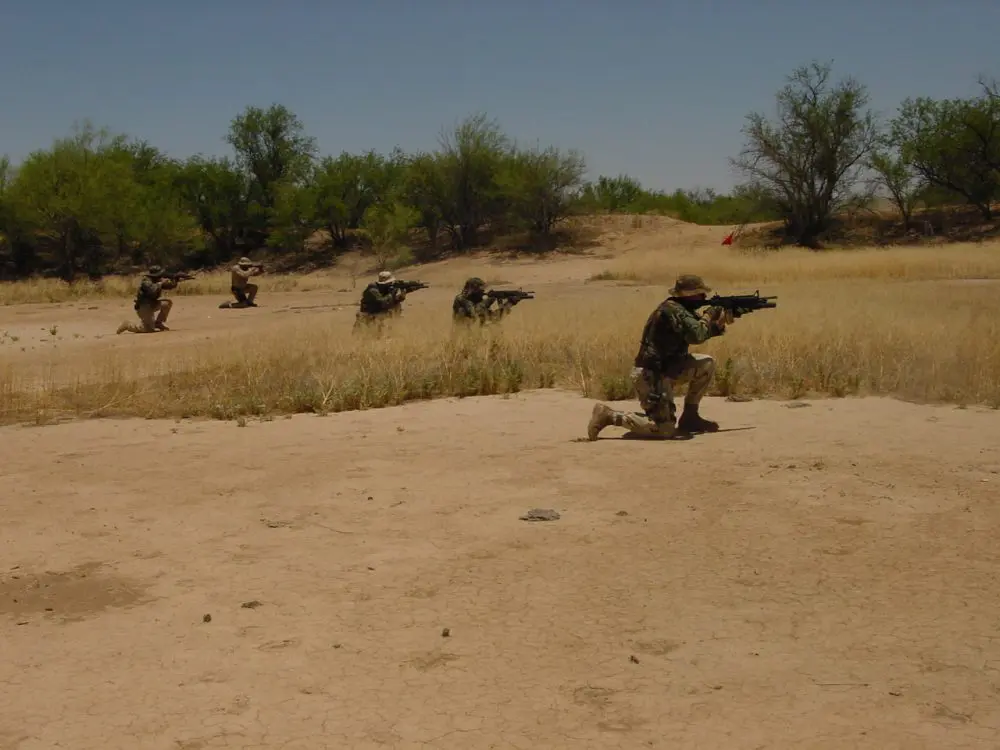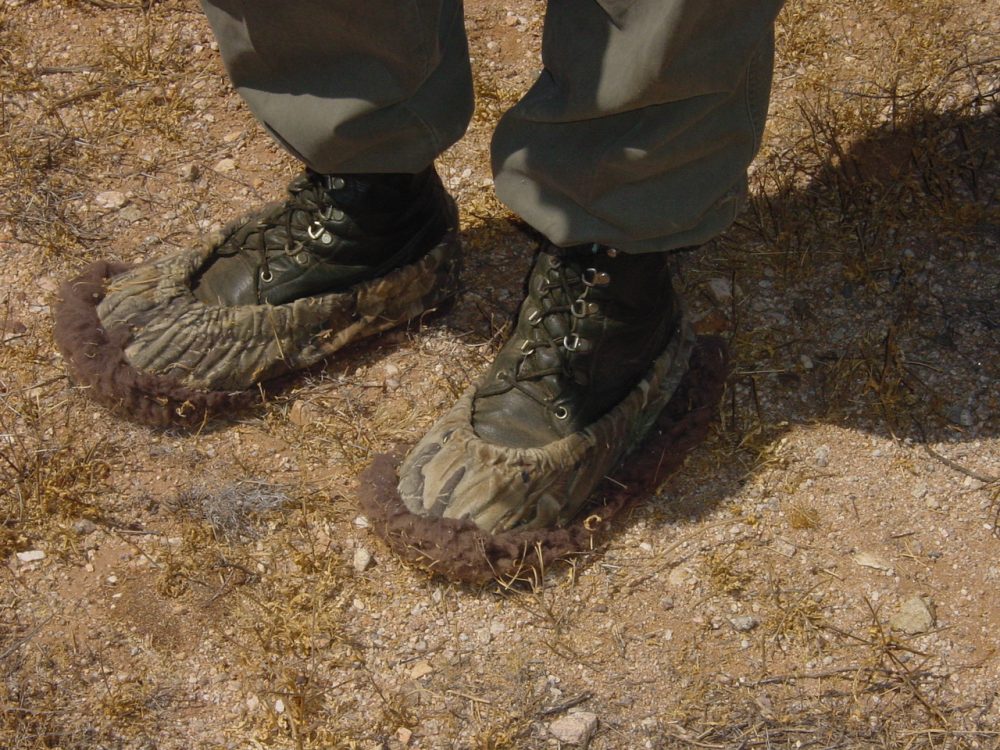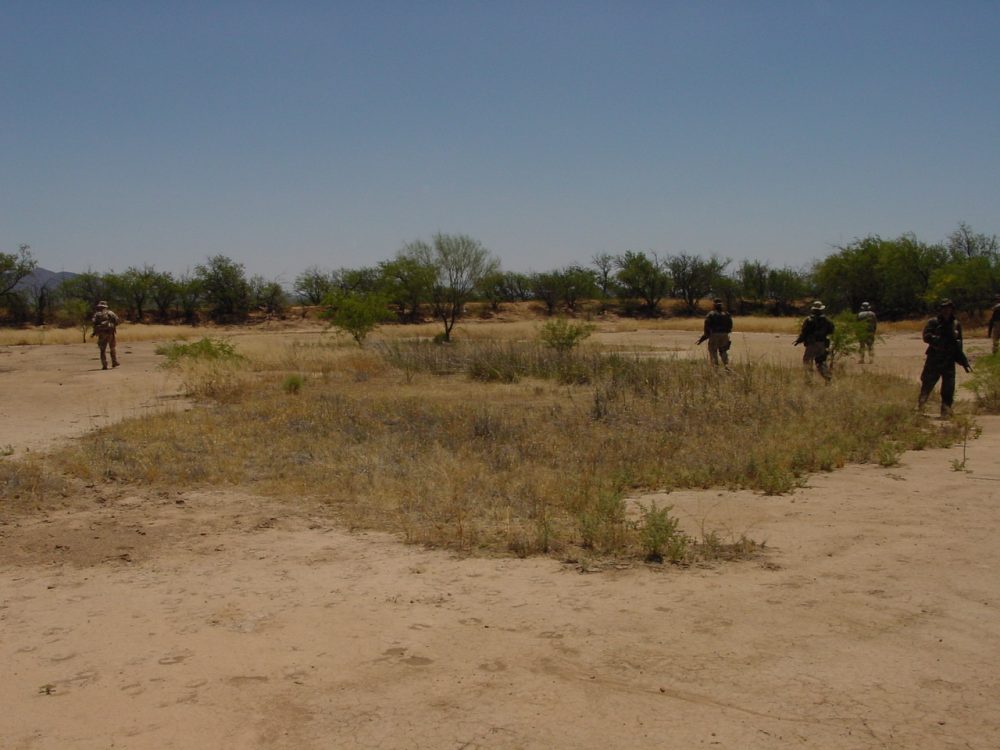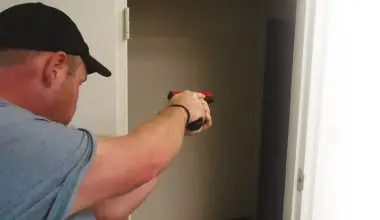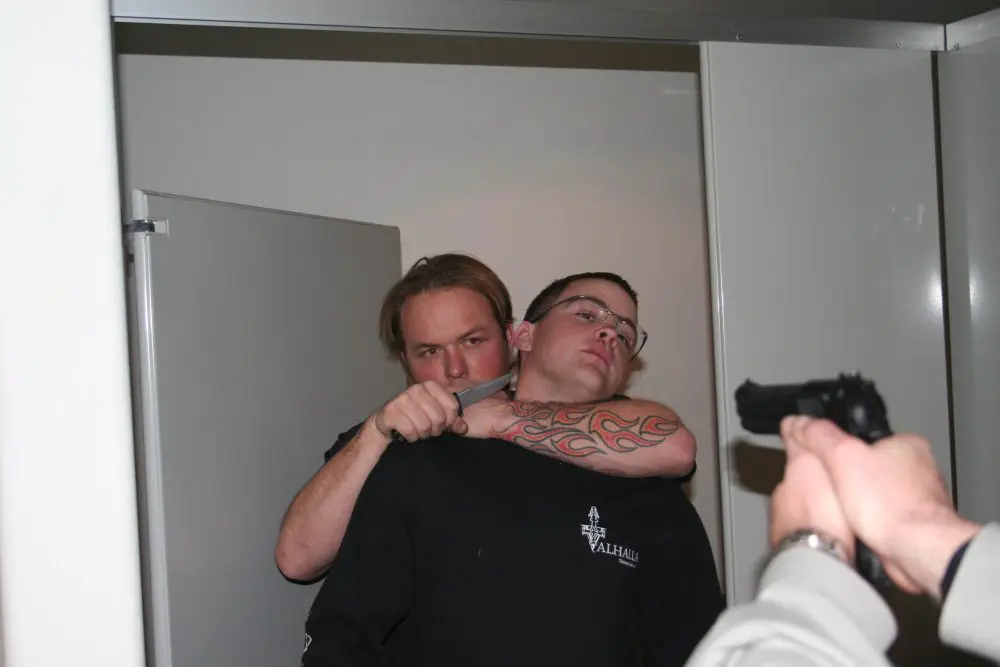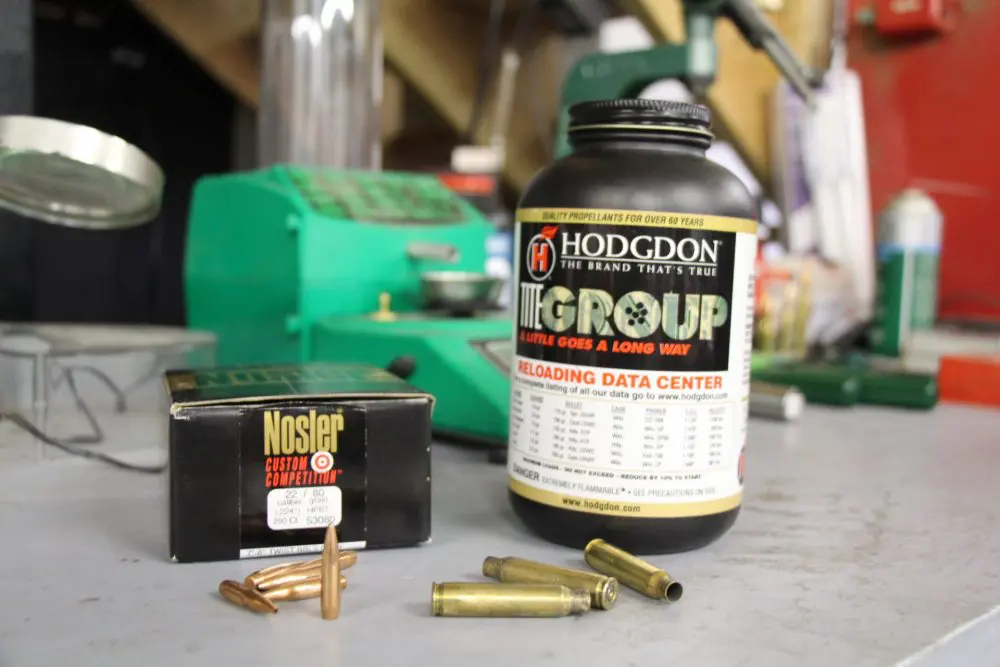Combat Tracking, also known as Combat Man Tracking, is a skill that is, for the most part, a forgotten art. Only when war rears its ugly head is the value of Combat Tracking recognized and appreciated. With our country at war, the art of combat tracking has been restored as an essential component of military training.
I recently had the honor of participating in a two-week Combat Tracking Level I & II class taught by David Scott-Donelan. The class was composed of students from the United States Air Force (USAF) and one sheriff’s deputy from Pinal County, Arizona.
Students on line firing into an ambush zone during the “cover shoot” training.
The classes were held in the southern Arizona desert during the second and third week of June 2005. If the word “desert” conjures up images of fine-grained sand and smooth dust that would make tracking ideal, think again. The high Sonoran desert is covered in many places by low vegetation and sun-baked, hard earth, which makes tracking far more challenging. The temperatures ranged from the mid 90s to a high of 108 degrees, which added to our difficulties.
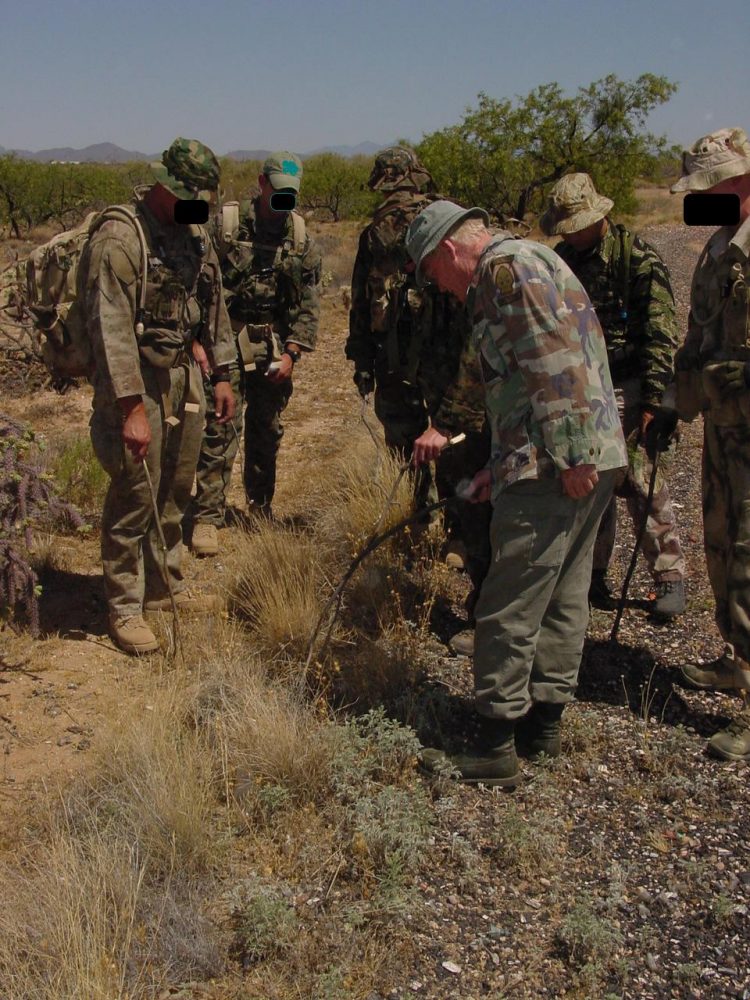
The course began with an overview of the curriculum. Immediately a few eyebrows went up amongst the students when it was explained that this class was not a search and rescue tracking class, but a combat tracking class. The object in combat tracking is not simply to track down quarry, but to aggressively track down and eliminate the enemy. Scott-Donelan explained that from that point on the enemy would be referred to as the “quarry” and the tracks the quarry left were to be referred to as “spoor.” Scott-Donelan continued by explaining the typical flow of a class: Monday we crawl through the learning. Tuesday, Wednesday and Thursday we are walking. By Friday we are running.
As an end to the overview, Scott-Donelan asked if combat tracking was a dying art with all the satellite reconnaissance and other advanced gizmos in the world today. Then he noted there are more trackers in the world today than ever before. In fact, many of our allies have combat tracking capabilities—do many of the countries which have a less than friendly relationship with the United States. This was another bit of information that was new to the students. During the next two weeks they were continually reminded of this fact.
What kind of a person makes a good tracker and what kind of characteristics should they have? Can anyone be a tracker? There are certain qualities that make good trackers. Short-fused, impatient, type “A” personalities should not be trackers—period. These folks generally become frustrated when they lose the spoor they are following. Losing the spoor is part of tracking and it cannot be avoided. Because of this inevitable fact, a tracker must be patient, persistent and extremely observant. A tracker, together with the tracking team, must have a level of physical fitness to be able to engage in on-going combat tracking operations for days at a time. Not only must trackers be physically fit, they must also be aware of their physical limitations. It’s better to take yourself and your team out of an operation if everyone is too exhausted to continue rather than jeopardizing the lives of the team.
The basic aim of a Combat Tracking team is to find and annihilate the quarry. This could include:
- Use of patrol and reconnaissance strategies to follow the quarry’s spoor.
- During tracking, also known as follow-up, operations keep such strong pressure on the quarry that it eventually wears down the quarry thus setting the ground for a successful contact.
- Locate, identify and interpret for intelligence purposes all material left behind by the quarry.
- Determine the quarry’s direction of travel to facilitate quick, efficient containment or other operations.
- Determine the approximate size, strength and capabilities of the quarry.
- Use anti-tracking skills and techniques to facilitate infiltration and exfiltration of hostile territory while minimizing spoor which could alert hostiles to the team’s presence.
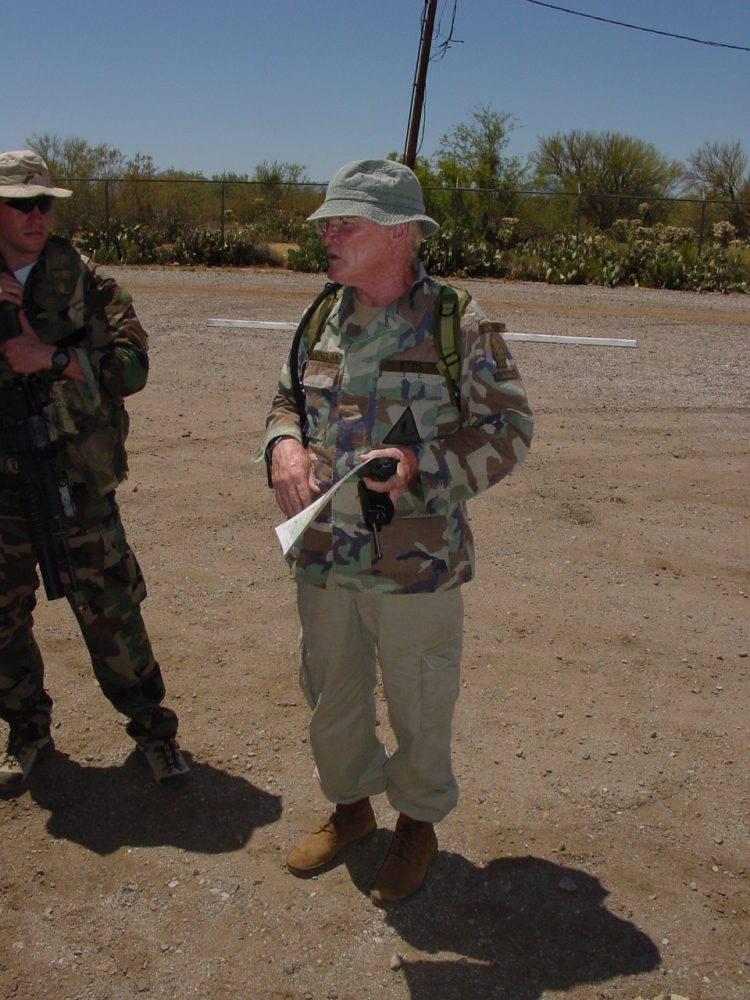
To ensure the students understood the terms that Scott-Donelan was going to be using during the next two weeks, a glossary of terms was explained together with the responsibilities of each member of the tracking team.
Students were taught procedures to re-locate lost spoor, including the 360-degree search and the box search—simple, yet very effective techniques.
One of the most interesting aspects of tracking is how we find spoor. In addition to the quarry’s obvious footprints, there are other details. For example: the type and outline of the spoor, the shape of the foot or footwear and the coloration or texture of the spoor compared to the surrounding ground. Spoor may have distinctly regular lines unlike anything in nature. Using light to your advantage, you can track during most of the day and, using LED lights, even well into the night. However, midday is the most difficult time to follow spoor because vertical sunlight creates no shadows inside the spoor to aid the tracker.
When using artificial lighting at night, remember you illuminate yourself and your team—making you visible to your enemy and vulnerable to attack. There are some available precautions. For example, passive night vision devices may be used or IR illuminators can cast shadows over the spoor while being viewed through night vision devices and not be visible to the naked eye. However, if your quarry has night vision capability, you and your tracking team could again be compromised.
Early in the first week the class was taken outside for a demonstration on the spoor pit—a clean area of soft dirt where students can view and interpret various spoor. For example, I walked through the spoor pit as though I had a purpose and knew where I was going. Next, I mimicked I was lost—looking toward the horizon for a point of reference. Where your head goes, so do your feet and it is reflected onto the ground spoor. Next, I walked through carrying a backpack containing about forty pounds of gear and food. The students were able to compare the different examples that I left for them in the pit. Attention to detail was drilled into the students at this point. They were reminded to look not only at the evidence that the quarry may be armed, but also to analyze the spoor even further. For example, if the quarry was armed, what weapons and equipment were they carrying? Did the quarry travel at night? How many individuals make up the quarry? There are many things that a good tracker can deduce from a simple interpretation of spoor.
Stalk Mocs, AKA Safari Sneakers, are used to obscure tracks and throw off a tracker. They are available from Crooked Horn Outfitters, www.crookedhorn.com.
The students were quick to pick up the material. Later in the first week, the skills learned in the classroom and in the spoor pit would be tested in the field. Students first started on short individual tracks of a hundred yards, carefully pointing out each and every spoor—a kicked rock, a bent twig that the student before them had walked over, etc.
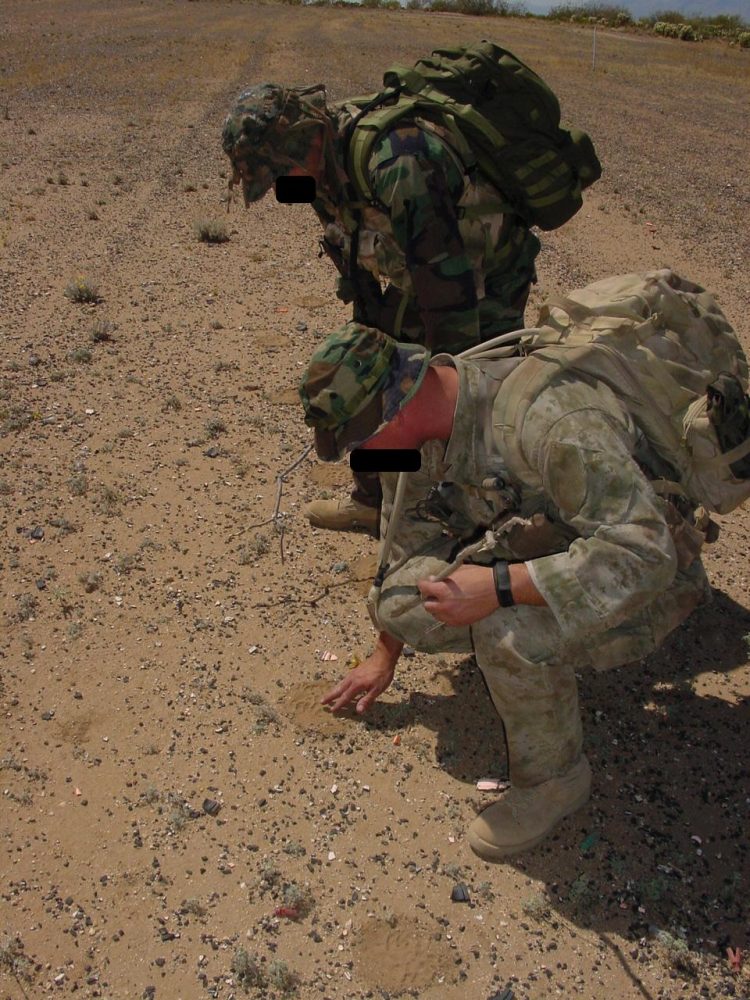
Once we had the basics of tracking down, we went on to the subject of tracking team formations—one of the most important subjects addressed during the first week of training. The students learned that the tracker sets the pace of the tracking team. Often, the tracker may outpace the other members of the tracking team, namely the left and right flank security, and could walk into trouble. After the classroom portion about tracking team formations, it was back out to the field for practical application of the material. I would walk out 400 to 500 yards and hide myself in a mesquite thicket—hopefully in a good enough position that I could observe the students and check out their formations as they approached. I was trying to see if the tracker was getting ahead of his flank security.
Besides the tracking team formation, the encounter action drills were of the utmost importance—what to do when you meet up with, bump into or stumble upon the quarry. Of course, every tactical scenario is different and decisions can only be made by the on-scene commander. Several of the students had what-if scenarios and they were addressed as concisely as possible. However, each tactical scenario is different.
After each classroom session came a trip to the field. The tracking exercises were getting more and more difficult. This was part of the crawl, walk, and run philosophy of teaching by which Scott-Donelan instructs his students.
In one scenario Scott-Donelan and I were to go ahead of the students and lay spoor for a good long track of approximately three or four kilometers. Near the end of the track there was a large open clearing and I cut directly across this clearing while Scott-Donelan skirted around it. We both met up on the other side and then lay in a small wash with creosote bushes covering us. We saw the students approximately fifty meters to our right front. I was expecting them to cross the open field in their formation. However, I think they sensed we were near and they held back in a small unit defensive formation while the tracker and another member of the tracking team scanned the surrounding bush with their binoculars. I was sitting with an olive green shemagh over my head and both tracking team members were looking right at me. But they were not sure what they were looking at since I was being absolutely motionless. To me, it seemed like a very long time before they finally realized that it was a person they were looking at in the bush and got on line and assaulted where we were hiding. This illustrated the importance of at least two of the tracking team being equipped with binoculars. A good thing to point out about this training day was that the entire tracking team was never exposed enough to be engaged and destroyed.
Before we knew it, the week of Combat Tracking I was over. Combat Tracking II, the second week, had longer tracks for the students, together with command and control scenarios.
The students were introduced to the report acronym LINDAT: Location (grid reference using GPS plot), Number (number of individuals in the quarry), Direction (their direction of travel), Age (of the spoor), and Type (footprints or other evidence or material left behind by the quarry). The students were expected to make use of this command and control situation report format until the end of the course. They were also expected to pay close attention to detail and to collect and report anything they found during the follow-up.
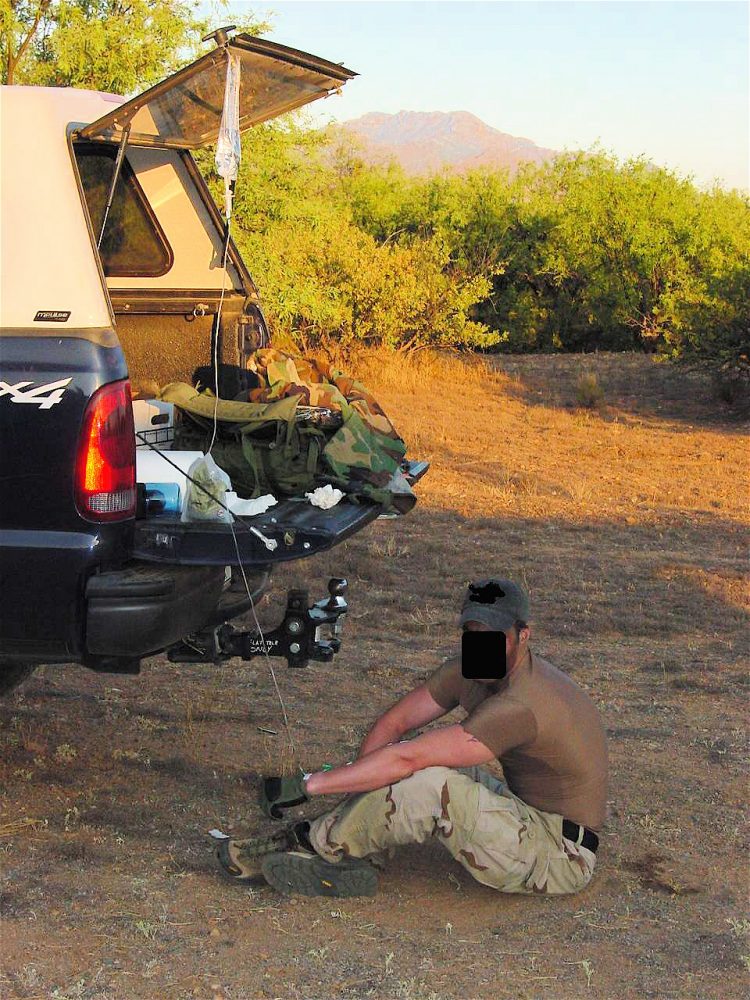
During the second week of the tracking course the students learned the various methods of anti-tracking and counter-tracking. For obvious operational security reasons, I cannot go into great detail on this subject. Anti-tracking skills are used to prevent the enemy from discovering that a team is in their operational area and to determine if anti-tracking methods are being used by the quarry. Later this week, anti-tracking methods would be used against the students; therefore everyone paid close attention to this fascinating information.
For three days and one overnight exercise the class traveled to a federal wildlife refuge next to the Mexican border. The purpose of training at the refuge was to provide the students with long tracks in different, difficult terrain in an area rife with illegal immigrant traffic. The goal was to have students concentrate on following our spoor, but there would be a great deal of other spoor in the area.
Scott-Donelan explained the “cover shoot” was created during the bush war in Rhodesia as a way of breaking an ambush and increasing the body count. When the enemy initiates an ambush, the team gets on line facing the enemy and fires in a box approximately eighteen inches square to the left and right of trees and large bushes. This exercise also proved that small twigs and branches deflect 55-grain, 5.56 bullets much more than heavier 148-grain bullets used by the Pinal County Sheriff’s deputy in his Para Model FN FAL in 7.62×51 NATO.
The last track was long—more than eight miles. The weather was extremely hot with temperatures well above the 100-degree mark. During a pre-exercise safety briefing, we warned the students to remain hydrated and not to exert themselves to the point they would need to be carried out of the refuge. Scott-Donelan and I then laid the spoor.
The students gave us a forty-five minute head start before they started after us. During this track we employed all of the anti-tracking procedures that the students were taught. As Scott-Donelan and I were heading to a large hilltop to observe the students approach, we came across a trail complex that would almost rival the Ho Chi Minh trail during the war in Vietnam. As we followed the trail we saw evidence of recent campsites of illegal immigrants and evidence that narcotic smugglers were in the area. I marked the area on my GPS so I could later share this location with the local wildlife refuge officers and Border Patrol. We estimated sixty-plus illegal immigrants walked one trail, over eighty on another. The sheer volume of human traffic through this area was simply astounding. The students performed very well. They detected all of our anti-tracking procedures, continued on our spoor and were not confused by the other spoor in the area. After three days in the hot desert we all were spent—mentally and physically.
The completion of the three-day field exercise brought us to the final day of the two-week combat tracking course. The final day was a command and control exercise where the students received LINDAT reports and plotted the location and information from each report. The purpose here was to create an overall view of the operational big picture.
Students track in formation seconds before a simulated ambush.
Table of Contents
OBSERVATIONS
Unlike the Tactical Tracking courses, which are geared solely toward law enforcement, the Combat Tracking course is a natural force continuum on the modern battlefield. It’s an excellent intelligence-gathering tool for higher command. At the end of Combat Tracking I will you be an expert tracker? No, but you and your team will have the tools necessary to become expert trackers—if practiced.
RECOMMENDATIONS FOR THIS COURSE
Be sufficiently fit to walk eight miles carrying the gear needed to sustain yourself in the field. Be ready to learn and to take notes. David Scott-Donelan is a natural teacher and he creates a strong learning environment.
Finally, as I said in a previous article on Tactical Tracking (S.W.A.T., January 2005), make sure your footwear is comfortable and broken in. If you are wearing a new pair of boots for this course, you will regret it.
SOURCE:
Tactical Tracking Operations School
Dept. S.W.A.T.
P.O. Box 2523
Mesquite, NV 89024
(928) 347-5377
www.members.aol.com/mantrack
